
Should You Buy the Mac Pro?
The Mac Pro was created to be Apple's most powerful Mac, offering extreme performance and a large amount of modularity and configuration options, and it is specifically aimed at those who need access to PCIe expansion slots for storage, audio and video I/O, networking, and more.
If you just want performance but don't need the flexibility of adding additional components, the M2 Ultra Mac Studio offers the same performance. Both machines have the same M2 Ultra chip inside, which makes the Mac Pro a specialized machine that is only for professionals who need its specific capabilities.
Apple refreshed the Mac Pro in June 2023, which means now is a good time to buy the Mac Pro. Apple is not expected to refresh the Mac Pro until 2025, but it will get faster M4 chip technology at that time.
The Mac Pro is Apple's most modular desktop Mac, and it is priced accordingly, starting at $6,999. The M2 Ultra Mac Studio is priced starting at $3,999, while dropping down to an M2 Max chip lowers the starting price of the Mac Studio to $1,999. Apple also offers the Mac mini, which is a desktop machine that is more affordable. It is outfitted with the M2 or M2 Pro chip and is not as powerful as the Mac Studio or the Mac Pro.
The 2023 Mac Pro
Contents
Apple in June 2023 refreshed the Mac Pro and added Apple silicon chips, making it the last Mac in the lineup to make the transition away from Intel. All Macs, Mac Pro included, are now equipped with M-series chips, with the Mac Pro adopting the M2 Ultra.
The M2 Ultra chip is the same chip that's in the Mac Studio, but the Mac Pro offers a different thermal setup and upgradeability and expansion not available with the Mac Studio. The Mac Pro is designed to be a high-end high-throughput machine that is aimed at pro users.
Positioned as Apple's largest desktop machine, the Mac Pro has an Apple-esque stainless steel frame and aluminum housing that offers 360-degree access to the internals of the system. There are optional wheels for movement, and handles are built into the frame to make it easy to reposition. Apple also offers a rack mount upgrade.
The M2 Ultra version of the Mac Pro has not seen a notable design update compared to the prior Intel-based 2019 model. It features the same lattice design that maximizes airflow and enables quiet operation. The Apple silicon version of the Mac Pro runs quieter and cooler than the prior Intel model.
Pricing on the Mac Pro starts at $7,000, and as it offers the same performance as the $4,000 Mac Studio with M2 Ultra chip, it is a specialized machine that is not for everyone. It is worth purchasing only if you need PCIe expansion, and that's generally limited to audio and video professionals and those who need additional networking and storage capabilities.
There are seven total expansion slots available, six of which are PCIe gen 4 for 2x more bandwidth for audio and video I/O, networking, and storage cards. One slot (PCIe gen 3) is dedicated to an Apple I/O card.
The M2 Ultra chip inside the Mac Pro is essentially two M2 Max chips connected together on a single die and able to perform as one unified chip, which Apple calls UltraFusion architecture. It features a 24-core CPU and a 60-core GPU (upgradeable to 76-core), along with a 32-core Neural Engine, 800GB/s memory bandwidth, up to 192GB Unified Memory, and a super fast Media Engine with four ProRes encode and decode engines.
Apple says the Mac Pro with M2 Ultra chip is up to 3x faster than the prior-generation Intel model. While the prior version of the Mac Pro had a separate Apple Afterburner accelerator card, the technology is built into the Apple silicon Mac Pro. According to Apple, the M2 Ultra Mac Pro has the performance of seven Afterburner cards.
The M2 Ultra supports playback of up to 22 streams of 8K ProRes 422 video and works with up to eight 4K displays. The Intel model supported up to 1.5TB of RAM, but that is not possible with the Apple silicon chipset, and so these new machines are limited to 192GB.
The base Mac Pro ships with a 1TB SSD, but it is upgradeable to 8TB. Apple also separately sells SSD upgrade kits for those who want to upgrade at a later date.
There are eight Thunderbolt ports, two high-bandwidth HDMI ports, two USB-A ports, two 10Gb Ethernet ports, and a 3.5mm headphone jack. It offers the faster Wi-Fi 6E protocol and Bluetooth 5.3 support.
Note: See an error in this roundup or want to offer feedback? Send us an email here.
How to Buy
The Mac Pro is priced starting at $6,999. It is available for purchase from Apple's online store and Apple retail locations. As of September 2023, Apple is selling refurbished versions of the M2 Ultra Mac Pro models at a discounted price.
Design
Apple's 2023 Mac Pro features the same design as the 2019 Mac Pro, with no external design updates to the chassis. Apple built the Mac Pro to be modular, upgradeable, customizable, and able to handle some of the highest-end components available on the market.

The Mac Pro uses a traditional tower-style design, but with an Apple flare. There is a stainless steel frame that supports the overall system, with mounting points for the interior components.
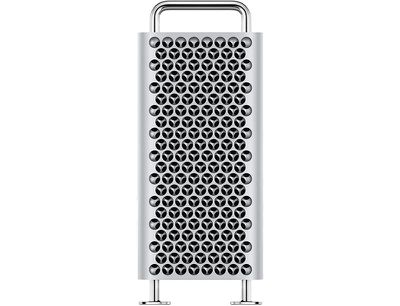
When the aluminum housing of the Mac Pro is removed, complete access to the system is available for adding and removing Mac Pro components.
The Mac Pro is equipped with the M2 Ultra chip and also needs to support additional I/O, so it has an impressive thermal architecture. Three impeller fans push air across the Apple silicon chip, and there's a blower that pulls air across the other components before it's vented out the back.

Covering the Mac Pro is an aluminum housing that Apple designed to be more than just a decorative shell. It acts as a seal for the internal cavity, and paired with the fans and blower, it helps maintain the air pressure that keeps the Mac Pro cool. With this system, the Mac Pro operates nearly silently.
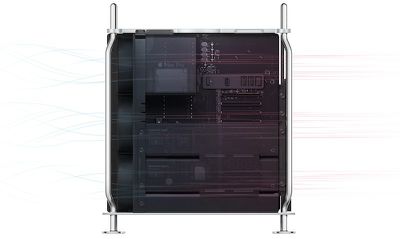
The aluminum housing is covered with a lattice pattern of three-dimensional interlocking hemispheres, which Apple based on a naturally occurring phenomenon in molecular crystal structures. The lattice pattern increases the surface area of the Mac Pro's enclosure, which optimizes the airflow while also providing a rigid structure.

Stainless steel handles at the top make removing the housing easy to get to the internals. Apple designed the handles to be part of the frame, so the Mac Pro is stable when lifted or moved. The top of the Mac Pro houses a twist latch that secures the enclosure to the frame.

There are optional wheels that can be added to the Mac Pro to make it easy to transport from one location to another.
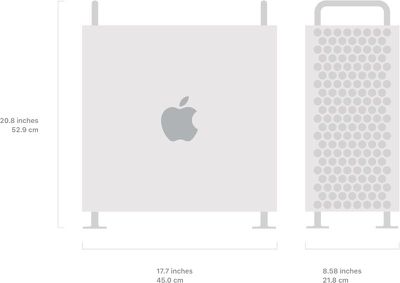
The Mac Pro measures in at 20.8 inches tall, 17.7 inches long, and 8.58 inches wide. With its optional wheels, it's a total of 21.9 inches tall. The Mac Pro weighs in at 37.2 pounds, and it is Apple's largest desktop Mac.
Internals
The Mac Pro features the most powerful components that Apple offers, and the design of the device makes it customizable to meet the needs of Pro users.

It has seven PCI Express expansion slots, six of which are available and one with an Apple I/O card installed. The prior-generation Intel-based Mac Pro had eight total open PCIe slots, depending on configuration. The Mac Pro includes two x16 slots and four x8 slots. Apple maintains a list of compatible PCIe cards, and unlike the prior model, it does not support graphics cards.
Processor
The Mac Pro is only available with a single chip configuration, and it ships with the M2 Ultra chip that's also used in the Mac Studio. The M2 Ultra chip is basically two M2 Max chips working together to form a single chip for double the performance of the M2 Max. Apple uses UltraFusion, a custom-built packaging architecture, for the M2 Ultra.
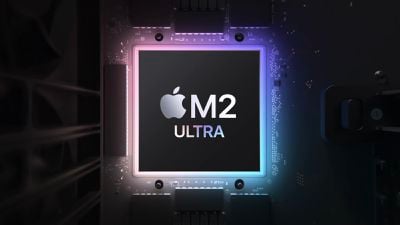
The M2 Ultra features a 24-core CPU with 16 performance cores and eight efficiency cores. There's a 60-core or 76-core GPU and a 32-core Neural Engine, along with 800GB/s memory bandwidth.
M2 Ultra benchmarks suggest the machine features a single-core score of 2837 and a multi-core score of 21730, which means the CPU is up to 20 percent faster compared to the M1 Ultra chip. It is by far the fastest Apple silicon chip that Apple has released to date.
The 24-core CPU is up to 1.8x faster than the 28-core Intel-based Mac Pro, while the 76-core GPU offers up to 3.4x faster graphics performance than the same machine. It supports up to 22 streams of 8K ProRes video playback.
Intel versions of the Mac Pro had a separate T2 chip with Secure Enclave, but that is now built into Apple silicon chips. Apple also no longer has a separate Afterburner card for the Mac Pro.
There is no option to upgrade the CPU of a Mac Pro, and it does not support graphics cards.
The Mac Pro does include a Media Engine that offers hardware-accelerated H.264, HEVC, ProRes, and ProRes RAW. There are two video decode engines, four video encode engines, and four ProRes encode and decode engines.
Memory
The Mac Pro supports up to 192GB unified memory, which is built into the Apple silicon chip. Unified memory architecture allows the CPU, GPU, Neural Engine, and SSD to access the same data pool, with no need to copy data between one another.
Memory in the Mac Pro is not user upgradeable, and it may be a downgrade from the Intel-based Mac Pro for some users. The prior-generation Intel-based Mac Pro supported up to 1.5TB of RAM.
Storage
The Mac Pro can be configured with up to 8TB of SSD storage. It is upgradeable, and Apple is selling standalone upgrade modules for the M2 Ultra machine.
The base Mac Pro comes with a 1TB SSD, which can be upgraded to 2TB, 4TB, or 8TB.
Ports
The Mac Pro includes eight total Thunderbolt 4 (USB-C) ports, six of which are located at the back of the enclosure and two of which are on the top of the enclosure. Thunderbolt 4 ports support transfer speeds of up to 40Gb/s.

There are also two USB-A ports (5Gb/s speeds), two HDMI ports, two 10Gb Ethernet ports, and a 3.5mm headphone jack that supports high-impedance headphones.
Inside the Mac Pro, there's one USB-A port (5Gb/s speeds) and two Serial ATA ports (6Gb/s speeds).
Other Features
Input Devices
The Mac Pro ships with a silver and black Magic Keyboard with Numeric Keypad and a black Magic Mouse 2. A black Magic Trackpad 2 is available as an add-on.
The Mac Pro also ships with a power cord, a USB-C to Lightning cable, and a 1.4-kilowatt power supply.
Connectivity
The Mac Pro supports the fastest Wi-Fi 6E connectivity, so it can connect to 6GHz networks where available, and it supports Bluetooth 5.3, the newest Bluetooth protocol.
It includes two 10Gb Ethernet ports, with support for 1Gb, 2.5Gb, 5Gb, and 10Gb Ethernet using RJ-45 connectors.
Audio
The Mac Pro features built-in speakers along with a 3.5mm audio jack with support for high-impedance headphones.
Display Support
The Mac Pro offers support for up to eight displays. It can run eight displays with 4K resolution at 60Hz, six displays with 6K resolution at 60Hz, or three displays with 8K resolution at 60Hz.
Build-to-Order Options
There is only one base Mac Pro model available, priced at $6,999 for the tower build or $7,499 for a rack mount version. The base Mac pro includes the M2 Ultra chip with 24-core CPU, 60-core GPU, and 32-core Neural Engine, plus 64GB unified memory and a 1TB SSD.
There are additional upgrades for the Apple silicon chip, memory, and SSD.
- Apple M2 Ultra with 24-core GPU, 76-core GPU, and 32-core Neural Engine - +$1,000
- 128GB unified memory - +$800
- 192GB unified memory - +$1,600
- 2TB SSD - +$400
- 4TB SSD - +$1,000
- 8TB SSD - +$2,200
With the exception of the SSD, no Mac Pro components can be upgraded after purchase.
Other Upgrades
Adding a stainless steel frame with wheels to the Mac Pro costs $400, as a frame with feet is the standard option. The wheels do not lock in place, which is something to be aware of.
Purchasing wheels after a Mac Pro has been ordered can be done with the wheel add-on kit, which is priced at $700. For Mac Pro owners who purchased wheels and would rather have feet, Apple offers a $300 feet kit.

The Mac Pro comes with a Magic Mouse 2, but can be upgraded to a Magic Trackpad 2 for an additional $50. Mac Pro buyers can get both the mouse and the trackpad for $149.
A rack mount option for the Mac Pro costs an additional $500, starting at $7,499.
Pro Display XDR
To go along with the Mac Pro, Apple designed the Pro Display XDR, a 32-inch 6K display with a resolution of 6016 x 3384 and more than 20 million pixels.
The display offers 1,600 nits peak brightness and 1,000 nits sustained brightness, it features a super-wide viewing angle, and a 1,000,000:1 contrast ratio for what Apple calls extreme HDR.
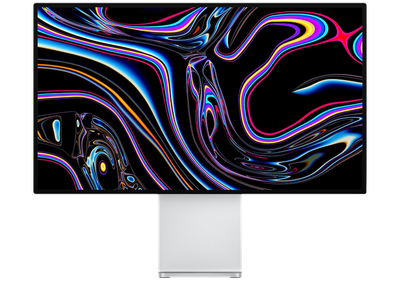
The Pro Display XDR was designed to look similar to the Mac Pro with a lattice pattern that doubles as a thermal system. It features edge-to-edge glass with a 9mm border and it is sold alongside a Pro Stand that can shift from portrait to landscape mode.
For more on the Pro Display XDR, make sure to check out our Pro Display XDR roundup.
What's Next for the Mac Pro
Apple will refresh the Mac Pro sometime around mid-2025, according to a report from Bloomberg's Mark Gurman. The Mac Pro will be equipped with the highest-end version of the M4 chip, which is codenamed "Hidra." Based on the description of the chip, it could be positioned as an "Ultra" or "Extreme" chip.
Apple has been designing a new, more powerful chip for the Mac Pro due to criticism that the M2 Ultra chip was not powerful enough for the high-end machine. The M4 will be built on the same 3nm process as the M3 chips, but Apple supplier TSMC will likely use an improved process that boosts performance and power efficiency.
The Mac Pro could support up to 512GB Unified Memory, a notable increase over the current 192GB limit.

